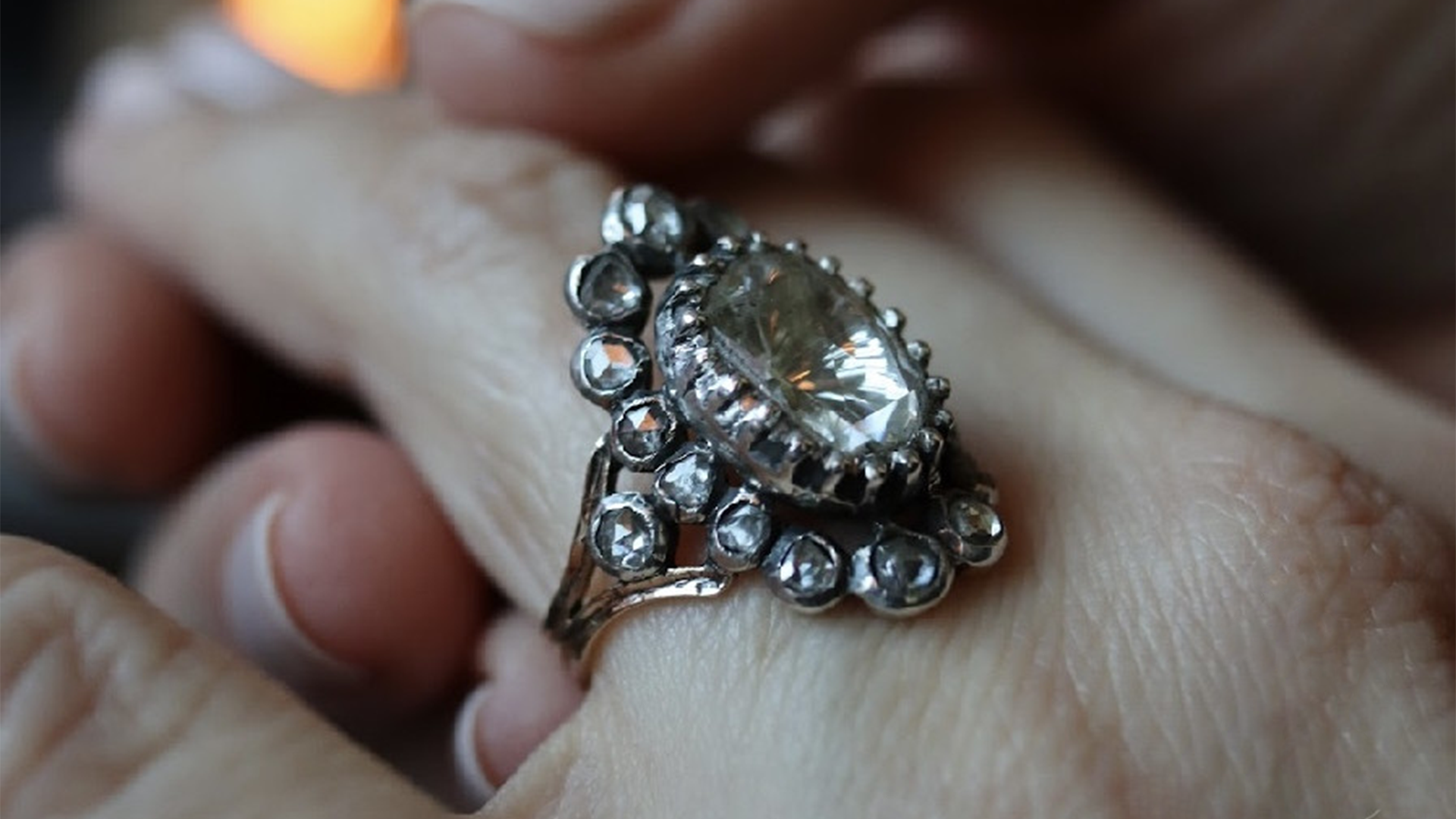Rose Cut diamond, 14-karat gold and silver, circa 1900, courtesy of French Collection
One of the most highly anticipated rituals around marriage is getting engaged and with that announcement comes a little something sparkly…usually a diamond ring. Engagement rings and wedding bands date back many thousands of years and they have evolved through the ages. While the exact origins of engagement rings are a bit murky, we do know that it was the ancient Romans who popularized these tokens of love.
Vein of Love
The Romans made rings from bone, ivory, copper, flint and iron. There were also gold rings for those who could afford it and it was common practice to have two rings — a gold ring to wear out in public and an iron ring to wear at home.
We can also thank the Romans for starting the practice of wearing an engagement ring on the fourth finger of the left hand. They believed that the vein in the finger next to the pinky on the left hand led directly to the heart and they referred to it as the “vein of love”. Some cultures wore an engagement ring on their index finger, or on their right hand, but the romantic notion of wearing a ring on the finger that connects to the heart caught on and continues today.
Engagement rings got the official nod of approval in 850 when Pope Nicholas I decreed that gifting a ring symbolized a man’s intent to marry. As we moved into the middle-ages engagement rings were elaborate affairs with generally a ruby or sapphire in an opulent setting. Gimmel rings were also a popular choice during those times. A gimmel ring is two rings that join together to become one. When a couple became betrothed, each person got one ring, on the wedding day the rings were put back together and both were worn by the woman. Another big advance in the engagement ring story came in 1477 when Archduke Maximillian of Austria proposed to Mary of Burgundy with a diamond engagement ring, the first one on record.
Diamond Engagement Rings Gain Favor
By the 1700s engagement rings were becoming more common, the Fede ring, which features clasped hands symbolizing the strength of marriage, was a favorite. In 1727 diamonds were found in Brazil, leading to a steady and regular supply of these gems, which were a must have for fashionable Georgians. The cluster ring featuring a diamond center stone with smaller diamonds around it was popular for engagement rings and sometimes included colored gemstone accents. It was during this era that King George III gave Queen Charlotte a diamond engagement ring widening its acceptance.
Three major events happened to further the diamond engagement ring’s place in society during the 1800s. First, the industrial revolution created a lot of new wealth and a burgeoning middle class with money to spend. The second event was the discovery of diamonds in South Africa in 1867, which provided an abundant supply of the sparkling gems. Then in 1886, Tiffany & Co. debuted the Tiffany Setting, a simple hoop with the diamond set high and six prongs holding it in place, allowing maximum light to flow through the stone creating exceptional sparkle. It was a big hit and the style continues to be desired by brides today.
Edwardian era engagement rings often centered on a diamond set in platinum with elaborate detailing from millegrain and piercing that gave the rings a light and airy look. The Art Deco era continued the movement of platinum (or sometimes white gold) engagement rings, but the white-on-white lacy look of the Edwardian days gave way to geometric forms often accented with ruby, emerald, sapphire or onyx to enhance the linear shapes. The late 1930s and 1940s saw gold return to favor as platinum was declared a strategic metal and was reserved for war use. Diamonds were often pulled from existing pieces to create a new engagement ring.
A Cultural Imperative
Diamonds solidified their position as the number one choice for engagement rings during the 1940s. With money tight during the 1930s due to the depression and a world war raging into the early 1940s, diamond sales dropped. Diamond miner De Beers, in conjunction with the NW Ayer advertising agency began marketing diamonds as a symbol of love. But the big break came in 1947, when the agency’s copywriter assigned to the account, Frances Gerety, was charged with finding a tagline for the gem that conveyed both its symbolic expression of love and its very practical nature of being durable. The story goes that while working late one night and out of ideas, she jotted down the phrase “A Diamond is Forever”. It caught on and the diamond engagement ring became a cultural imperative for the contemporary bride. In 1999 Advertising Age magazine named “A Diamond is Forever” slogan of the century.
After World War II ended, the 1950s saw a return to platinum settings in engagement rings. The most popular styles of the time were quite simple — a center diamond, prong set, embellished with two side stones. The popularity of this style continued for many years with gold once again becoming more favored from the 1960s to the 1980s. In the 1990s styles shifted once again and fancy shape center stones became more popular as did a mix of yellow gold and platinum for a two-tone setting. Moving into the early aughts, the halo setting became ubiquitous and continues its reign as a beloved setting.
Another shift that has taken place in recent years is that more couples are selecting colored gemstones, uncut diamonds or salt and pepper diamonds for the center stone to reflect their unique style. There are plenty of engagement ring choices, but if you take a step back in time, you’ll find a selection of distinctive vintage engagement rings that express your personality and your personal love story.
Authored by Amber Michelle
